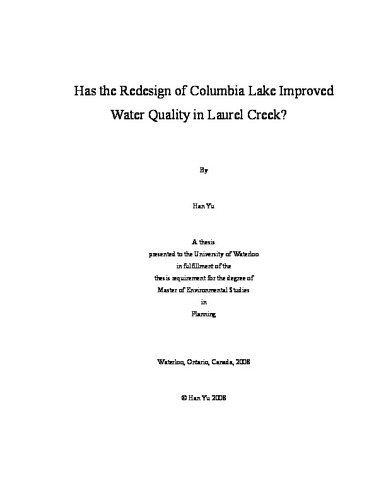| dc.description.abstract | Stormwater impoundments are one of many types of best management practices (BMP) designed and implemented to regulate water quantity and improve the quality of runoff from urban areas. Studies of water quality in urban impoundments have indicated that conventional designs are however, not very effective at removing solids and associated pollutants. Accordingly, many urban impoundments are being re-designed to improve downstream water quality. However, few studies have systematically monitored and quantified post-design water quality improvements of urban impoundments. This thesis examines changes in the water quality performance of an urban impoundment (Columbia Lake) in Waterloo, Ontario resulting from redesign of the lake for the pre-design period (2003 and 2004) and the post-design period (2006 and 2007). To achieve this goal, four years of water quality data collected at the inlet and outlet of Columbia Lake as part of the Laurel Creek Monitoring Program was measured. Water chemistry parameters included total phosphorus (TP), soluble reactive phosphorus (SRP), suspended solids (SS), dissolved oxygen (DO), pH and total dissolved solids (TDS). Inlet and outlet discharge (Q) were measured to determine the water retention time in the lake. Concentrations and loads of TP and SS for the post-design period (2006 and 2007) were compared to those for the pre-design period (2003 and 2004).
During the pre-design period (2003 and 2004), inflow TP concentrations ranged from 18 to 372 µg L-1 with an average (mean ± standard error) of 56±7 µg L-1, while outflow TP concentrations ranged from 37 to 266 µg L-1 with an average of 116±6 µg L-1. Post-design TP concentrations ranged from 10 to 124 µg L-1 with an average of 53±5 µg L-1 and from 14 to 147 µg L-1 with an average of 44±3 µg L-1 at the inflow and outflow, respectively. Pre-design SS concentrations ranged from 1.8 to 168.5 mg L-1 with a mean of 19.0±3.2 mg L-1 and from 4.0 to 194.7 mg L-1 with a mean of 66.6±4.7 mg L-1 at the inflow and outflow, respectively. Post-design SS concentrations varied from < 0.1 to 25.8 mg L-1 with an average of 8.5±0.8 mg L-1 and from < 0.1 to 42.5 mg L-1 with an average of 14.5±0.8 mg L-1 at the inflow and outflow, respectively.
Sedimentation/resuspension dominated the TP and SS transfer via Columbia Lake. Pre-design TP loads (log-transformed) strongly correlated with SS loads at the inflow and outflow (r = 0.661 and 0.777, p = 0.0001). These parameters were more strongly correlated during the post-design period (r = 0.794 and 0.915, r = 0.0001), which indicates that particulate P (PP) was a dominant fraction of TP and that the release of dissolved phosphorus (DP) from bottom sediments was considerably decreased following the redesign. No significant difference was observed between inflow and outflow SRP concentrations. Discharge strongly affected TP and SS loads at the inflow and outflow during the pre- and post-design periods (r > 0.79, p = 0.000 for all). After the redesign of Columbia Lake, the average net internal P loading rate decreased from 198% to 22% for TP. The primary factor influencing the observed decreased post-design TP and SS outputs was the removal of sediment from the lake. Bottom sediment removal and changes to the lake bathymetry reduced sediment resuspension and P desorption, which decreased the average net internal SS loading rate from 828% to 154%. The Columbia Lake Water Quality Model developed by Stantec Consulting Ltd. (2004) underestimated the post-design outflow TP and SS concentrations mainly because it did not include terms that account for factors such as bioturbation, wave induced resuspension and biological activity. | en |

